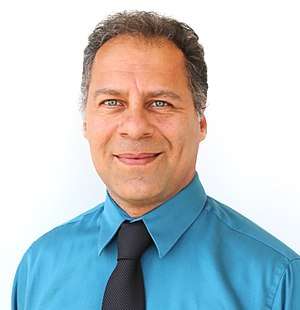Payam Heydari
Payam Heydari (Persian: پيام حيدرى) is an Iranian-American Professor who is noted for his contribution to the field of radio-frequency and millimeter-wave integrated circuits.[4]
Payam Heydari | |
|---|---|
 | |
| Nationality | Iranian, American |
| Alma mater | University of Southern California |
| Known for | Radio-frequency (RF) and millimeter-wave integrated circuits |
| Awards | IEEE Fellow[1] IEEE Darlington Award[2] IEEE Guillemin-Cauer Award[3] |
| Scientific career | |
| Fields | Electrical Engineering |
| Institutions | University of California, Irvine |
| Doctoral advisor | Masoud Pedram |
Education
Heydari attended Sharif University of Technology in Tehran and received his B.S. and M.S. degrees in Electrical Engineering in 1992 and 1995, respectively. He obtained his Ph.D. degree from the University of Southern California in 2001.[5] In 1997, he worked at Bell-labs, Lucent Technologies on noise analysis in high-speed CMOS integrated circuits fields. In 1998 he worked at IBM T. J. Watson Research Center on gradient-based optimization and sensitivity analysis of custom analog/RF ICs.
Career
Heydari is a professor of Electrical Engineering at the University of California, Irvine.[4] His research in the design of terahertz and millimeter-wave integrated circuits in silicon resulted in the world's first CMOS fundamental frequency transceiver operating at 210 GHz[6][7] and the first terahertz closed-loop synthesizer source operating at 300 GHz in silicon.[8] He introduced the first dual-band radar-on-chip with applications in automotive sensing and safety.[9] His contribution in millimeter-wave imaging led to the invention of new concept called "super pixels" in the context of imaging array receivers.[10] Heydari and his team discovered new transceiver architectures that obviate the need for high resolution data converters. This discovery led to the first "beyond-5G" integrated transceiver chipsets in silicon.[11][12]
Heydari is a Fellow of Institute of Electrical and Electronics Engineers (IEEE) for contributions to silicon-based millimeter-wave integrated circuits and systems. He is an IEEE Distinguished Microwave Lecturer,[13] and was formerly a Distinguished Lecturer of the IEEE Solid-State Circuits Society from 2014 till 2016. He received the 2005 National Science Foundation CAREER Awards.[14] Heydari is the recipient of both the IEEE Circuits and Systems Society Darlington and Guillemin-Cauer Awards.[15][16]
Heydari gave a keynote speech to the 2013 IEEE GlobalSIP Symposium and a Distinguished Speech to 2014 IEEE Midwest Symposium on Circuits and Systems. He serves on the Technical Program Committee of the International Solid-State Circuits Conference (ISSCC).[17]
Heydari and his research team have published more than 150 international conference and journal articles. They won both the first place and the best concept paper in the 2009 Business Plan Competition at The Paul Merage School of Business.[18][19] He is the lead principal investigator of the largest National Science Foundation Award ever received by a faculty member affiliated with the University of California, Irvine's Henry Samueli School of Engineering.[20] In February 2018, in its annual meeting, attended by more than 700 business executives, academic leaders and elected officials, the Orange County Business Council recognized Heydari as a "Game Changer, who is transforming the world by his scholarly work."[21][22]
References
- "IEEE Fellows" (PDF).
- "IEEE Darlington Award Recipients".
- "IEEE Guillemin-Cauer Award Recipients".
- "Payam Heydari | The Henry Samueli School of Engineering at UC Irvine". www.eng.uci.edu. Retrieved 2015-12-03.
- "Alumni Profile (Electrical Engineering) | Ming Hsieh Institute". mhi.usc.edu. Retrieved 2015-12-04.
- Wang, Zheng; et al. (March 2014). "A CMOS 210-GHz Fundamental Transceiver With OOK Modulation". IEEE Journal of Solid-State Circuits. 49 (3): 564–580. Bibcode:2014IJSSC..49..564W. doi:10.1109/JSSC.2013.2297415.
- "CMOS Transceiver Tackles 210 GHz with OOK Modulation". mwrf.com. Retrieved 2015-12-04.
- Chiang, Pei-Yuan (February 2014). "14.7 A 300GHz frequency synthesizer with 7.9% locking range in 90nm SiGe BiCMOS". Solid-State Circuits Conference Digest of Technical Papers (ISSCC): 260–261. doi:10.1109/ISSCC.2014.6757426. ISBN 978-1-4799-0920-9.
- Jain, Vipul (December 2009). "A Single-Chip Dual-Band 22-29-GHz/77-81-GHz BiCMOS Transceiver for Automotive Radars". IEEE Journal of Solid-State Circuits. 44 (12): 3469–3485. Bibcode:2009IJSSC..44.3469J. doi:10.1109/JSSC.2009.2032583.
- "UC Irvine and TowerJazz present 9-element fully integrated W-band direct-detection-based receiver". www.semiconductor-today.com. Retrieved 2015-12-03.
- "UCI electrical engineering team looks 'Beyond 5G' with new wireless transceiver". www.latimes.com. Retrieved 2019-07-26.
- "100 GHz Wireless Transceiver Takes Chip into Realms of 6G". www.eetimes.com. Retrieved 2019-07-29.
- "Distinguished Microwave Lecturers".
- "Calit2 : UCI Professor Receives NSF CAREER Award". www.calit2.net. Retrieved 2015-12-04.
- "Darlington Award | IEEE Circuits and Systems Society". ieee-cas.org. Retrieved 2015-12-03.
- "Guillemin-Cauer Award | IEEE Circuits and Systems Society". ieee-cas.org. Archived from the original on 2016-02-23. Retrieved 2015-12-03.
- "International Solid-State Circuits Conference - January 31 - February 4, 2016 - San Francisco, CA". isscc.org. Retrieved 2015-12-04.
- "Calit2@UCI". www.calit2.uci.edu. Retrieved 2015-12-08.
- "Engineering Nabs Top Honors in the 2009 Business Plan Competition at The Paul Merage School of Business | The Henry Samueli School of Engineering at UC Irvine". www.eng.uci.edu. Retrieved 2015-12-08.
- "UCI heads $8 million NSF-funded project to develop brain-computer interface".
- "Churm named chairman of OCBC; annual Game Changers named".
- "OCBC Recognizes Orange County 'Game Changers' at Annual Dinner; Welcomes Steve Churm as 2018 Chairman".